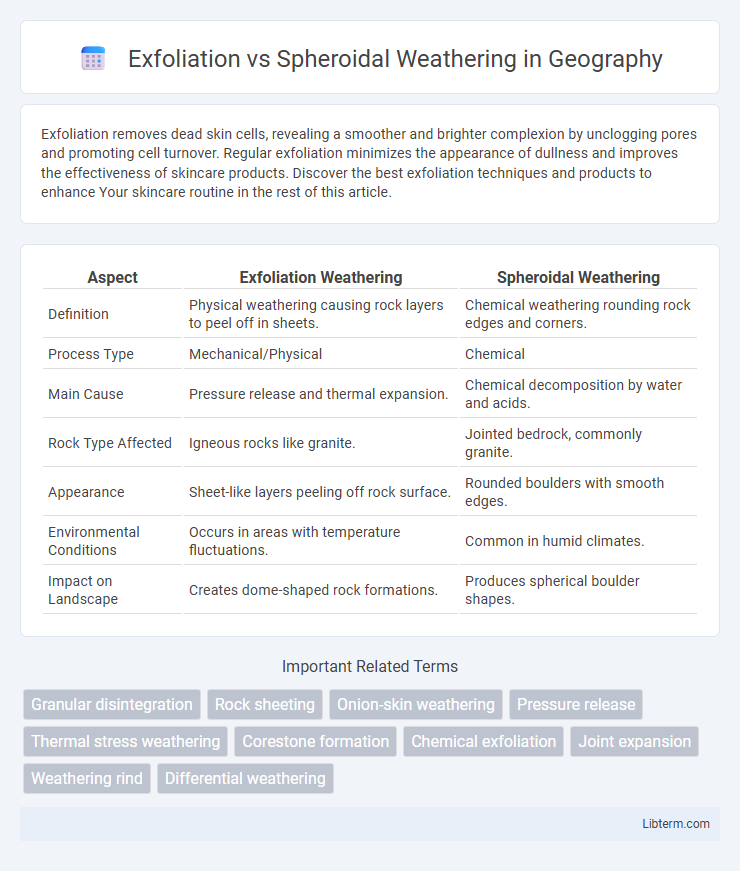Exfoliation removes dead skin cells, revealing a smoother and brighter complexion by unclogging pores and promoting cell turnover. Regular exfoliation minimizes the appearance of dullness and improves the effectiveness of skincare products. Discover the best exfoliation techniques and products to enhance Your skincare routine in the rest of this article.
Table of Comparison
| Aspect | Exfoliation Weathering | Spheroidal Weathering |
|---|---|---|
| Definition | Physical weathering causing rock layers to peel off in sheets. | Chemical weathering rounding rock edges and corners. |
| Process Type | Mechanical/Physical | Chemical |
| Main Cause | Pressure release and thermal expansion. | Chemical decomposition by water and acids. |
| Rock Type Affected | Igneous rocks like granite. | Jointed bedrock, commonly granite. |
| Appearance | Sheet-like layers peeling off rock surface. | Rounded boulders with smooth edges. |
| Environmental Conditions | Occurs in areas with temperature fluctuations. | Common in humid climates. |
| Impact on Landscape | Creates dome-shaped rock formations. | Produces spherical boulder shapes. |
Understanding Exfoliation: Definition and Process
Exfoliation is a weathering process where layers of rock peel away due to pressure release and temperature fluctuations, typically affecting granitic rocks. This mechanical weathering occurs as overlying materials erode, reducing confining pressure and causing the rock to expand and fracture parallel to the surface. Unlike spheroidal weathering, which involves chemical alteration and rounded edges, exfoliation primarily results from physical stress and thermal expansion cycles.
Spheroidal Weathering Explained: Key Concepts
Spheroidal weathering is a type of chemical weathering where rock layers peel away in rounded shapes due to the interaction of water and minerals, primarily affecting jointed, coarse-grained rocks like granite. The process begins with water penetrating joints, leading to the chemical alteration of minerals at rock edges and corners, causing them to crumble and form spherical layers. Unlike exfoliation, which involves physical peeling of outer rock layers due to pressure release, spheroidal weathering results from mineral decomposition and hydration, producing smooth, rounded boulders over time.
Geological Settings Favoring Exfoliation
Exfoliation commonly occurs in massive, homogeneous igneous rocks such as granite exposed at or near the Earth's surface in arid to semi-arid climates, where temperature fluctuations cause outer layers to peel off in sheets. This weathering process is favored by tectonically stable regions with significant unloading, allowing pressure release and subsequent expansion fractures parallel to the surface. Quartz-rich rocks with minimal jointing are particularly susceptible to exfoliation due to their brittle nature and thermal stress sensitivity.
Environments Where Spheroidal Weathering Occurs
Spheroidal weathering predominantly occurs in humid and tropical environments where chemical weathering processes like hydrolysis and oxidation are intense, causing rock edges to round as minerals decompose. This weathering is typical in granitic terrains with ample moisture, promoting the penetration of water along fractures and leading to the concentric peeling of rock layers. Unlike exfoliation, which is common in arid or temperate zones due to pressure release, spheroidal weathering thrives in warm, wet climates that foster deep chemical alteration of rock surfaces.
Physical Mechanisms Behind Exfoliation
Exfoliation results from the expansion and contraction of rock layers due to temperature fluctuations, causing outer sheets to peel away in a process known as thermal stress. In contrast, spheroidal weathering involves chemical alteration where water penetrates rock joints, leading to the rounding of edges through mineral decomposition. The physical mechanism behind exfoliation primarily hinges on mechanical stresses induced by unloading and thermal expansion rather than chemical processes.
Chemical Actions Driving Spheroidal Weathering
Spheroidal weathering results from chemical reactions such as hydrolysis, oxidation, and carbonation that alter mineral structures along fractures, promoting rounding of rock edges. Water infiltrates joints in the rock, facilitating the breakdown of feldspar minerals into clay and soluble ions, which accelerates mineral decomposition and rock disintegration. Unlike exfoliation, driven mainly by physical stress release, spheroidal weathering's chemical mechanisms critically depend on moisture and reactive fluids to transform rock chemistry and morphology.
Visual Differences: Exfoliation vs Spheroidal Weathering
Exfoliation displays distinct sheet-like layers peeling away from rock surfaces, often creating dome-shaped features with clear, curved fractures parallel to the surface. Spheroidal weathering, by contrast, results in rounded, smooth boulders where edges and corners are progressively rounded due to chemical weathering penetrating angular rock joints. Visually, exfoliation reveals sharp, plate-like slabs while spheroidal weathering produces more uniform, bulbous rock shapes with softened edges.
Rock Types Susceptible to Each Weathering Form
Exfoliation primarily affects igneous rocks such as granite and other intrusive rocks with massive, unjointed structures, where pressure release causes the outer layers to peel off in sheets. Spheroidal weathering targets jointed, coarse-grained igneous rocks like granite and diorite, where chemical weathering rounds off sharp edges by attacking corners and edges more intensively. Both weathering forms influence hard, crystalline rocks but differ by the physical stress in exfoliation and chemical dissolution in spheroidal weathering.
Implications for Landscape Evolution and Geomorphology
Exfoliation causes sheet-like layers of rock to peel off, significantly influencing dome-shaped landforms and promoting rapid surface area expansion in granitic terrains. Spheroidal weathering chemically alters rock by rounding edges and corners, leading to the development of corestones and spheroidal boulders that shape rounded hilltops and mantled slopes. Both processes contribute distinctly to landscape evolution by modifying rock exposure and erosion patterns, with exfoliation emphasizing mechanical disruption and spheroidal weathering enhancing chemical alteration in geomorphological contexts.
Comparing Exfoliation and Spheroidal Weathering: Summary Table
Exfoliation involves the peeling away of outer rock layers due to pressure release, predominantly affecting granitic formations with sheet-like fractures. Spheroidal weathering causes rounded rock shapes by chemical weathering along jointed rock edges, commonly impacting coarse-grained igneous rocks. The comparison highlights exfoliation as a physical process driven by mechanical stress, while spheroidal weathering is primarily chemical, altering rock structure and appearance over extended periods.
Exfoliation Infographic

 libterm.com
libterm.com